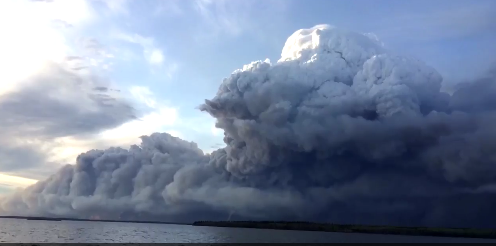City-Threatening
Wildfires — The North’s New Climate Future
7
July, 2016
That great roaring sound you’re hearing may just be another 3.6 billion dollar climate disaster…
*****
Reports are in and it’s official — the Fort McMurray Fire was the costliest disaster ever to impact Canada. According to the Insurance Bureau of Canada (IBC), claims of damages for the massive Alberta wildfire have now topped 3.6 billion dollars. That’s worse than the Alberta floods of 2013 at 1.8 billion dollars (ranked third), and worse than the great Quebec ice storm of 1998 which inflicted 1.9 billion dollars (in 2014 dollars) in damages.
(Fires in northern regions and within the Arctic are now so energetic that they often produce pyrocumulus clouds — like this one which was thrown off by the Fort McMurray Fire.)
CEO Don Forgeron of IBC stated that the damage from the fires provide “alarming evidence” that extreme weather events have increased in frequency and severity in Canada. And that’s especially true for wildfires — which are being worsened by a climate change driven warming. The added heat is lengthening the fire season in Northern Latitudes even as it is generating temperatures that are inhospitable to trees that have adapted to live in much cooler climates. It’s also thawing the permafrost — which adds more peat-like fuels for fires to burn.
The Fort McMurray fire erupted under these new climate conditions and under temperatures that were 40 degrees (Fahrenheit) above average at the time of ignition. It forced the entire city of Fort McMurray to empty. It resulted in the evacuation of 90,000 people, the (darkly ironic) temporary shut down of various fossil fuel production facilities, and leveled 2,400 structures. Many more structures were damaged due to smoke or falling embers. In total, more than 27,000 property claims were filed.
(Dozens of massive wildfires burn through Central Siberia on July 7th of 2016 in this LANCE MODIS satellite shot. For reference, bottom edge of frame is 220 miles. These kinds of events, according to Greenpeace, burned 8.5 million acres last year in Russia. It’s a new climate context that is turning northern regions into a fire hot zone and it’s not at all normal.)
Unfortunately, this fire is unlikely to be a one-off event. Year after year, an Arctic warming at 2.5 to 3 times the rate of the rest of the globe pulls heat northward. Earlier thaws and added fuels combine explosively with swaths of dead trees killed by rampaging invasive species that have arrived from the south. No northern or Arctic nation has been untouched by the extreme fires. Alaska, Canada, and Siberian Russia have all seen extraordinary and massive fires during recent years. Fires that throw great pulses of heat and burning debris high into thunderheads of flame called pyrocumulus clouds. A word that climate change has now added to the popular lingo.
Links/Attribution/Statements:
Hat tip to Colorado Bob





No comments:
Post a Comment
Note: only a member of this blog may post a comment.